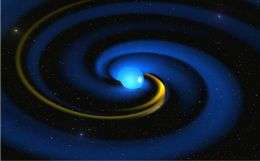Hottest Stars in Delicate Embrace by Spiral Arms

(PhysOrg.com) -- A team of scientists at the Royal Observatory of Belgium (ROB) announced today that the hottest and most massive stars are wrapped in spiraling waves of hot gas. These winding waves, which have sizes as large as our Solar System, have long been expected since the mid 1980ies, but the team could - for the first time - study the intricate wave properties using new supercomputer simulations.
New high-performance computer modeling shows that copious winds blown off hot and heavy stars are neither smooth nor featureless. The steady wind flow turns out to be pervaded by gigantic mass-strings winding up around the fast-spinning surface. The new supercomputer models are an important leap forward to pinpoint the physical mechanisms that feed and shape the environments of luminous and fast-evolving stars.
The team at the ROB carefully re-examined spectroscopic line data of a key blue star - known by the number "HD 64760" - in the Southern constellation of Puppis, observed by the International Ultraviolet Explorer (IUE) in 1995. The IUE data set contains special absorption features observed with unprecedented detail and time-resolution. The line features drift over time and are known to trace out broad lanes of wind material flung off its surface. They are also frequently observed in many other massive hot stars.
Although similar streams of mass from the Sun have been observed in the Solar System since the 1960ies, their physical properties could not be studied with sufficiently detailed and advanced theoretical models to correctly mimic and fully explain the spectral data sets. Using the large supercomputer shared by the Royal Observatory, the Meteorological Institute and the Institute for Space Aeronomy, the ROB team put the brand new digital workhorse to work for modeling the stars as well.
The ROB scientists could now calculate large amounts of very sophisticated three-dimensional models for the complex wind structure of HD 64760. They continued to compare the computed spectra with the observed data until a nearly perfect match was found. What they discovered in the final best model was against the odds; HD 64760 has a pair of feeble tentacles swirling in huge spirals around its equator.
"We are amazed to find that our 3-D model calculations with the new supercomputer can explain the detailed time-variability of the spectral line observations of HD 64760 to an astonishing level of accuracy.", said Dr. Lobel.
The new science results have an important bonus to them. The models also show that the spiral arms are in fact large density waves that sprout from bright spots on the surface of the star.
"Our computer model unravels the physical nature of these remarkably frail spiral arms with perplexing detail. We had a pretty good idea of what they should roughly look like, but it is the first time we were able to also track them back to rotating faint hotspots on the surface of HD 64760", explained Dr. Blomme.
The team published the results in the Astrophysical Journal, available online at adsabs.harvard.edu/abs/2008ApJ...678..408L
The ROB team is stepping up further research on HD 64760 following the new breakthrough. A key result for the equatorial hotspots is that they rotate about five times slower than the visible surface. The spiral waves are clearly too weak to appreciably alter the loss of mass from the star.
Scientists envision several explanations for the bright spots. One explanation considers very ordered magnetic fields that could perhaps locally change the surface brightness. Another possibility is periodic waves due to nonradial pulsations. The waves travel the stellar circumference, collide, and co-add into bright surface areas at the equator. The wave origin for the spots is favored by other observations of HD 64760, including optical monitoring at the European Southern Observatory.
Future research by the team will establish firm links between the physics of the atmospheres and environments of the most massive stars in the Galaxy.
This research was supported by the Belgian Federal Science Policy Office. The science team mentioned in this news release consists of Drs. Alex Lobel and Ronny Blomme (Royal Observatory of Belgium).
Related links:
www.astro.oma.be/HOTSTAR/CIR/CIR.html
alobel.freeshell.org/hotstars.html
Provided by Royal Observatory of Belgium




















